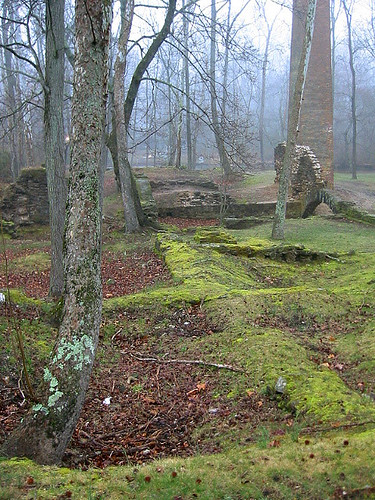ACCESS AND PARKING: Open daily from dawn to dusk with ample parking. Gated after hours. Relatively swift water in Spring and after rains on the Great Egg Harbor River. Use caution with small children.
SPECIAL FEATURES: The smokestack and ruins in the park are the remains of a circa-1800 bog iron furnace. The bog iron industry was important to United States effort against the British in the War of 1812. Not much is known about the specific room functions of the structure, but further excavation and rehabilitation may reveal more in the future.
A CLOSER LOOK: For a slightly longer paddle along the Wild and Scenic Great Egg Harbor River, begin at Penny Pot Park and end at Weymouth Furnace. To reach Penny Pot Park, exit Weymouth Furnace Park and turn Left onto Weymouth Road. Turn Right onto Route 322. After 4.6 miles turn Right onto 8th Street. There will be a small parking and launching area 0.1 miles on the right.
SITE DESCRIPTION: With an iconic smokestack and ruins harkening back to the bog iron and paper mill days of the 1800s, Weymouth Furnace Park is one of the most popular and well known of all Atlantic County Parks. Located at the junction of Black Horse Pike and the Great Egg Harbor River, accessibility and amenities such as charcoal grills, picnic tables and benches make this site perfect for family outings and casual birding. An easy five-mile canoe or kayak cruise down the Great Egg Harbor River from Weymouth Furnace to Lake Lenape is the best way to experience the Pine Barrens and all of the unique flora and fauna of this pristine watershed.
DON'T MISS: An easy five-mile canoe or kayak cruise down the Great Egg Harbor River from Weymouth Furnace to Lake Lenape is the best way to experience the Pine Barrens and all of the unique flora and fauna of this pristine watershed.
THROUGH THE SEASONS:
Winter: The park is fairly quiet and attractive as a meditation site. Winter resident birds include Red-bellied Woodpecker, Downy Woodpecker, White-breasted Nuthatch and Blue Jay. The running water attracts mixed flocks of Carolina Chickadee, Tufted Titmouse, Carolina Wren and Yellow-rumped Warbler. Winter specialties to keep an eye out for include Golden-crowned Kinglet, Yellow-bellied Sapsucker, Winter Wren and Fox Sparrow. Great Blue Heron occasionally fish along the banks.
Spring: The Park comes to life with migrant songbirds such as Red-eyed Vireo, Eastern Phoebe, American Redstart, Blue-gray Gnatcatcher, Baltimore Oriole and Common Yellowthroat, among others. Myrtle periwinkle blooms around the ruins and violets decorate the grassy areas. Spring peeper, Fowler’s toad, American toad, green frog, pickerel frog, red-backed salamander and red-spotted newt are among amphibians that are becoming active. Raccoon and opossum tracks are sometimes visible in the mud. Moths and butterflies such as spring azure, comma and mourning cloak flutter around spring buds.
Summer: Listen for calling Louisiana Waterthrush downstream and nesting woodland birds such as Gray Catbird, Wood Thrush, Ovenbird, American Robin, Rose-breasted Grosbeak and American Goldfinch. Chipmunks gather food in the leaf litter. Look for dragonflies and damselflies hunting in the open woods and streamside vegetation. Frogs and the occasional garter snake can be glimpsed near the natural spring. Sunfish, pirate perch and pickerel are among fish that call the river home. The full canopy makes this park a good respite from summer's heat. Insect repellant recommended.
Fall: The large oak, maple, birch, poplar and beech trees along the river turn beautiful colors. Gray squirrels and chipmunks forage in the open woods. Southbound migrant songbirds such as Hermit Thrush, Eastern Towhee, Yellow-billed Cuckoo, Cedar Waxwing, Black-and-White Warbler and Ruby-crowned Kinglet use the river as a corridor, as do raptors such as Coopers and Sharp-shinned Hawks.
Source: NJwildlifeTrails.org
20120103
weymouth furnace ruins
Subscribe to:
Post Comments (Atom)


No comments:
Post a Comment